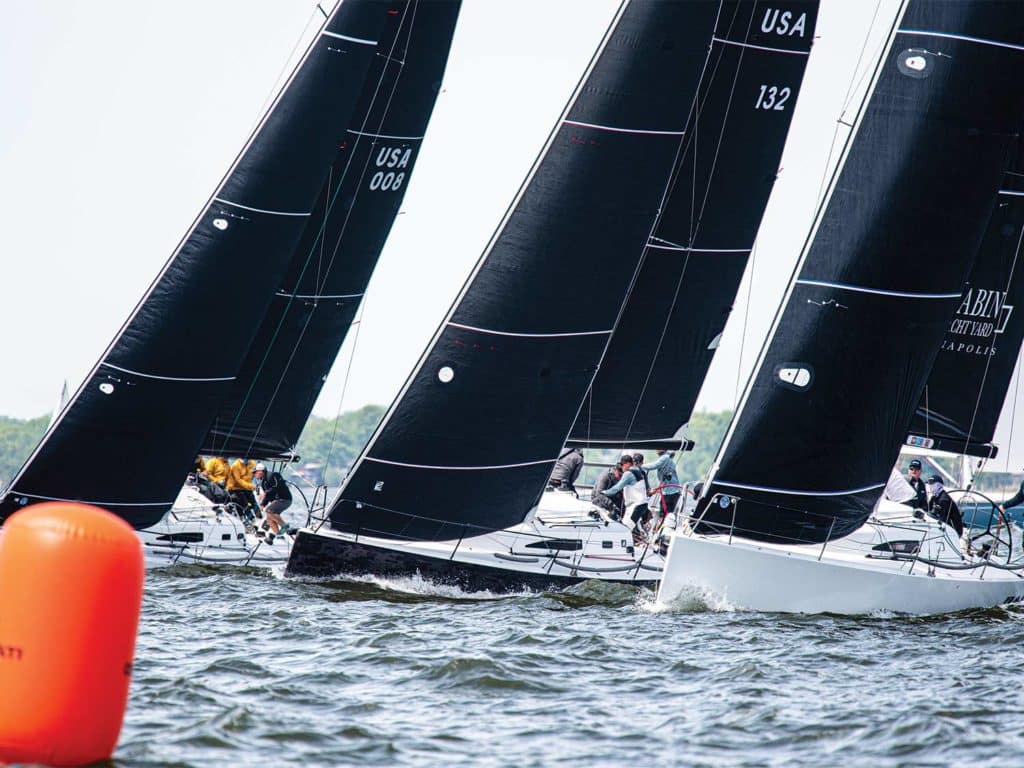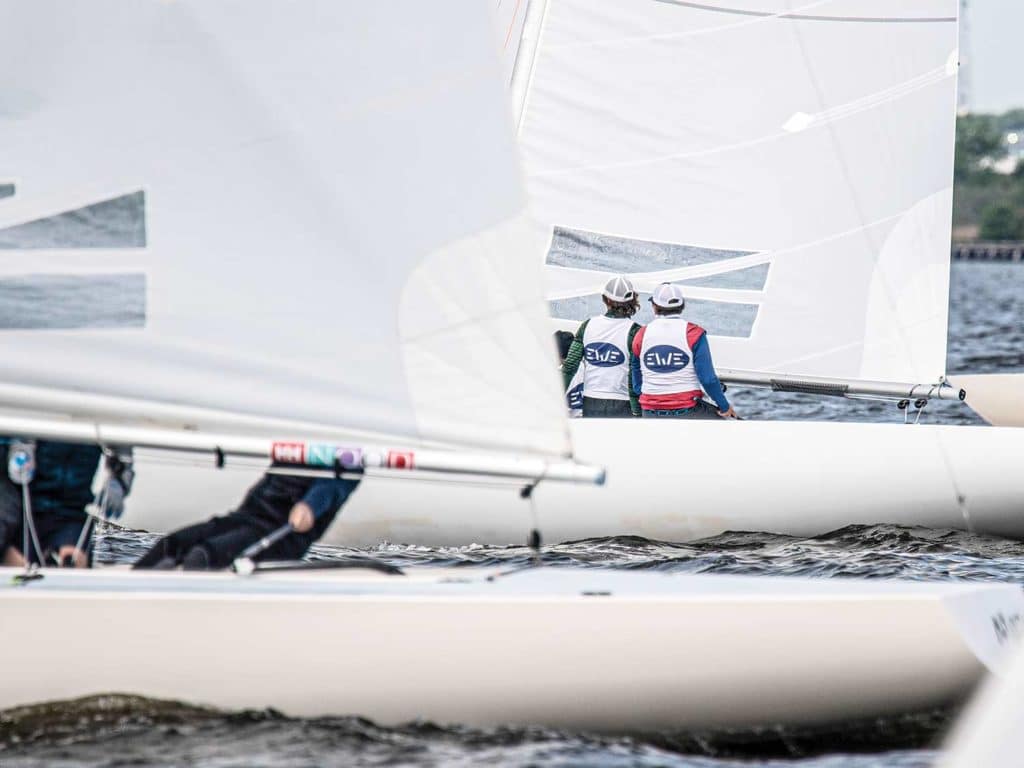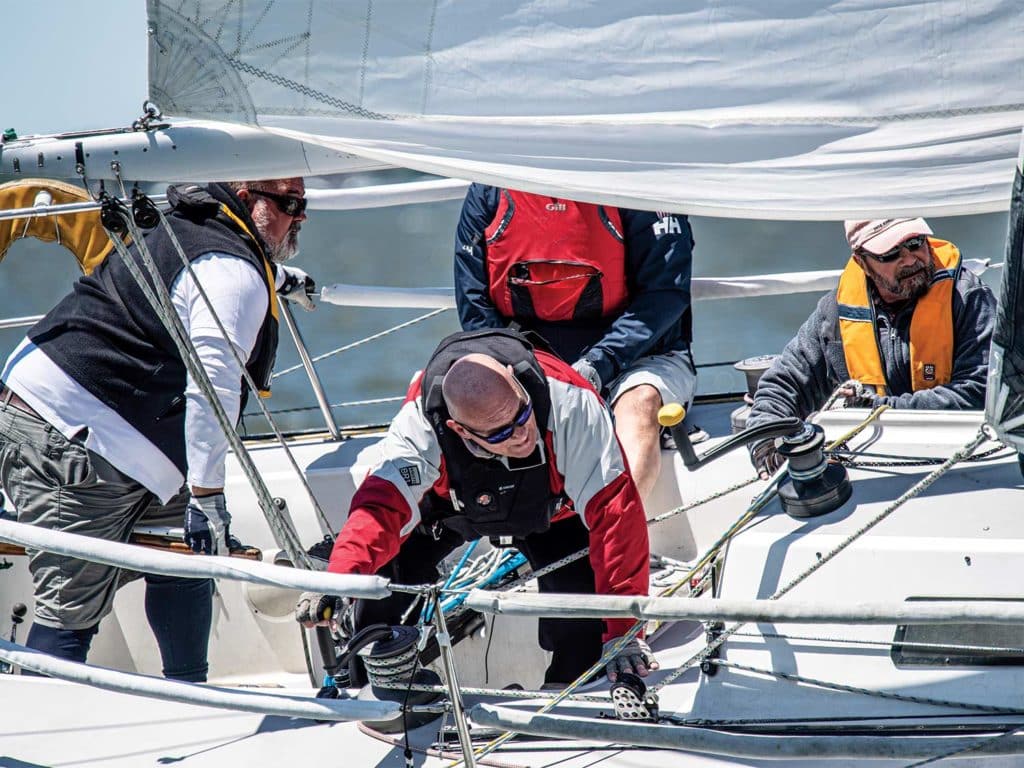
When the race committee hoisted its AP-over-A on the morning of the first day of racing at the Helly Hansen NOOD Regatta in Annapolis, there was a collective sigh across the Annapolis YC’s dry sail lot. Yes, everyone was anxious to go racing after a year of tiptoe racing through the pandemic, but not everyone was keen to scuff off the rust in a 30-knot gale.
So, with coffees in hand, crews tinkered and mingled with friends. A few teams eventually sneaked out to practice in the harbor, but most of Rob Ruhlman’s crew went golfing instead. There was no good reason to go out and practice on their J/111, flogging sails and crew before their big-deal North American Championship. They hadn’t sailed since January, at the class’s winter championship in Key West, but they’d be ready, Ruhlman reasoned. Feeling ready and being ready, however, are two different things.
The one wrinkle they weren’t prepared for was the race committee’s use of a rolling three-minute starting sequence the following morning when starting signals finally got underway. The short countdown caught Ruhlman’s team off guard in the morning’s first race. Twenty-knot gusts only fueled the confusion.
“We had trouble getting used to the three-minute-start thing,” Ruhlman says. “I get it in Lasers, but with 37-footers?”
Without a good start in this class, Ruhlman says, it’s nearly impossible to get to the front. This would, of course, account for his Spaceman Spiff being sixth (of seven boats) in the first race of the regatta. Rust in the boathandling cog of the machine didn’t help.
“These boats are so even, and there are all top-notch guys that travel,” he says, “so there’s no room for mistakes.”
Peter Wagner’s team on Skeleton Key, trained in the big breeze of their hometown San Francisco Bay, were confident in the day’s chaotic blow and won the first races comfortably. They were able to get off the starting line clean and control their own race, Wagner says.
“That was pretty important because, with the shifts, things were changing quickly, and we had to be able to react to the changes as they happened.”
By the final race of the day, however, Ruhlman’s crew was in its groove. Their score line trended upward, with a second to close the day. Skeleton Key had its first stumble, hung out on the wrong side of a windshift and finishing fourth. “We got stuck a little too far left and couldn’t quite find a shift to come back,” Wagner says. “Our friends on Spaceman Spiff face-planted us at a critical moment, bouncing us back left and sealing our doom. That was a good move by them.”

That fourth also narrowed the series to mere points between the top three boats, with Spaceman Spiff lurking in fourth.
“We went home that day feeling fine,” Ruhlman says, “and not a single person walked out the door in the morning expecting to go out and win the day—or the regatta. We weren’t feeling a lot of pressure.”
Skeleton Key, however, was perhaps feeling the pressure and got caught over early in the morning’s first start.
“An OCS is almost impossible to overcome,” Ruhlman says. “In this fleet, getting back is incredibly difficult.”
Not only did Spiff win that one, but it won the next, inching the crew closer to the top of the mountain. “We always take it one race at a time,” Ruhlman says, “And, in fact, when we crossed the finish line in the last race [a fourth-place finish], my son said, ‘I think we just won the North Americans.’ I know he’s good with math, but I said I’m going to wait and see how the numbers work out.”
The story was similar for J.R. Maxwell and his mates on the J/22 Scooby. Their results after the breezy opening day were what he called “consistent” in the 15-boat fleet, and after winning the next day’s first two races, Scooby was well on its way to winning the regatta. But, like Wagner’s Skeleton Key, the race committee called Maxwell’s number—and it took a while. Looping back to restart, they looked up the course and knew the work ahead.
“We had to grind back from being second to last and finished fifth in that race,” Maxwell says. “It was all about staying in the puffs. It wasn’t always intuitive of where that was going to happen.”
A fifth in that race was good enough for the win. Sailing with Maxwell on Scooby were Jim Schmicker and Matt Spencer (and Bryan Pryor sailing on Saturday only), and as the winner of the J/22 class, they were also selected as the regatta’s overall winners, earning a berth to compete in the Helly Hansen Caribbean NOOD Championship in October in Sunsail-provided bareboats.
The J/35s are a legacy class of the Annapolis NOOD, and while the fleet was smaller in numbers this year with only four to show, the battle at the top of the fleet was a mighty one, with Roger Lant’s Abientot winning the tiebreaker over the perennial champions of James Sagerholm’s Aunt Jean. It took everything they had, Lant says, plus a little luck.
“Aunt Jean is very, very fast upwind, so if you let them get away, it’s a tough battle after that, so we worked on a strategy to deal with them on the starting line,” Lant says. “But we carried out our plan, and it went well.”
What exactly was that plan?
“The boat that won the start won the race,” Lant says. “They were looking for space on the starting line, and we were looking to engage, so [on the first day] we engaged them fairly hard.”
When Aunt Jean won the day’s first two races the following morning, Lant had only one option: to win the final race. He who wins the last race wins it all.
“We knew we had to control him at the start,” Lant says, “but we also had to win the start and get clear.”
They also needed top-shelf crew work.

“I’m the most fortunate skipper on the course,” Lant says. “I have a core crew that has been sailing together for three years, and the skills keep building, and we had some of the most fabulous crew work I’ve ever seen on the boat—exceptional.”
Lant, of course, got his win and local bragging rights—for now.
On the same circle were the J/80s, also an Annapolis NOOD legacy class. Conor Hayes and Jeff Kirchhoff’s J/80, More Gostosa, didn’t have a stellar first day, but on the second, “flawless crew work” saved them.
When it’s said that every point counts, Hayes would agree because one point was ultimately the difference. Having won the penultimate race, Hayes knew the points were extremely close between his team and Daniel Wittig’s Turbo Sloth, but he had no idea how close. All he could do for the last race was keep Sloth in his wake.
“We had a tough start in that last race,” Hayes says. “We wanted to start at the pin but got shut out. We were able to tack out immediately onto port and were in phase. From there, it was a matter of staying in more wind. It helps to have boatspeed and a good crew to be able to get out of bad situations.”
Similar accounts were common across the 153-boat regatta, even over on the 40-boat J/70 line that was so thick with professionals, you could practically see dollar bills streaming behind in their wakes as pro-am teams fought tooth and nail for narrow lanes and clean air.
Travis Odenbach’s Honeybadger was king for a day after the first, but the late assault came from USA 419, with Terry Hutchinson on the tiller. Even he had to pull off a few miracles.
In the start of Sunday’s first race, for example, Hutchinson doubted his GPS starting instrument, hesitated, and was immediately buried after the start. “We didn’t trust the Velocitek,” Hutchinson says. “We were poked, and I didn’t pull the trigger. It was a rookie mistake.”
Hutchison? Rookie? Pshaw.
With the focus of his crew, Scott Nixon, Dan Morris, Gil Hackel and Jennifer Wulf, they clawed their way back to an eighth-place finish—no small feat when the flood tide was running in at full tilt. It was this comeback, Hutchinson says, that ultimately won his team the regatta.
“It’s amazing how hard this racecourse is in Annapolis,” Hutchinson says of the home waters he’s supposed to know like the back of his hand. “The course location was hard because the current was good on the right, but there was pressure and shift on the left, so you had to balance the two. You did not want to be in the middle. In the first race, the leader came out of the right, and in the second, the leader came out of the left. Each leg was unique to itself, which kept us on our toes.”
Over on the J/30 line there were 10 boats, but the battle was really between the top three—Bob Rutsch and Mike Costello’s Bebop, Bruce Irvin’s Shamrock, and Tristan Keen’s Infectious Smile. The three of them were passing ones, twos and threes like hot potatoes, but Bebop ultimately snagged the win. “My crew had not raced together since 2019,” Rutsch says, “so to get back together and go out in 20 knots and not break anything was amazing. We had a killer first race—with a monster lead—on the first day, and that really got us going for the weekend.”
Rutsch has lost track of how many times Bebop has won the NOOD since his father bought the boat in 1983—maybe 11 times—but winning it never grows old. “I used to say to my dad, in the ’80s and ’90s, ‘Man, I hope we’re still around after 25 years like the Alberg 30s.’ We’re still out there. They’re still out there. It’s a beautiful thing.”
Speaking of the Alberg 30s, it was Pat Siedel’s Laughing Gull that set one of the regatta’s picket fences, often finishing five minutes ahead of the fleet. “When it was really sporty on Saturday, most of the guys were flying No. 2s and blades,” Siedel says, “but we opted to reef down and go with a No. 1, and that really helped us. Plus, the guys were all over the crew work.”
Flawless boathandling is also what got Jose Fuentes and the Caramba Etchells squad to the top of its fleet. Fuentes, who lives over the border in Washington, D.C., says the NOOD is his No. 1 regatta, and this one felt especially important, sailing in honor of former crewmate and local sailor Geoff Ewenson, who recently passed away. Ewenson, he says, would have been proud. “I don’t think we had a speed edge over the rest of the boats,” Fuentes says. The big difference was the crew work. It was flawless—every tack, every rounding, every jibe.
Making easy work of the regatta in the J/24s was Tony Parker’s Bangor Packet. Tyler Moore’s squad prevailed in the Viper 640s, and Bill Zartler’s experienced team owned the 21-boat J/105 fleet from start to finish. In the new North Sails Doublehanded Distance Race, Mike Beasely and Chris Coleman conquered the windy 20-mile racecourse to win on Beasley’s GP26, Rattle N Rum. ν









